Tracheid-like tubes in Rhynie chert
While
most of the chert samples from Rhynie, which are famous for their often
well preserved Devonian fossils, offer only things already known from
that site, a few of the samples may provide surprises, even multiple
ones. This is the case with the sample where Figs.1-5 have been taken
from.
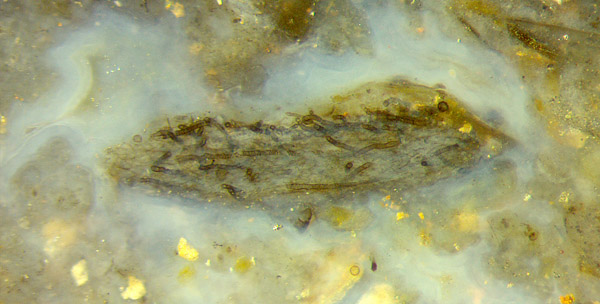
The nematophyte in Fig.1 seems to be rather similar to Nematothallus known
as compression fossils [1]. It is tentatively called Nematothallus
here, for simplicity. This specimen is a former lump of (probably
organic) gel with worm-like tubes inside, seen enlarged in Rhynie
Chert News 107.
Judging from the whitish
chalcedony
surrounding it, this Nematothallus
lump had got washed into a water-filled cavity in the (probably
anorganic) gel in the swamp matter becoming silicified. Nothing similar
has been seen elsewhere, hence this tiny fragment may be the only
specimen of Nematothallus
found in chert hitherto.
Fig.1: Worm-like tubes with patterned walls, width 19-23Ám, in a
separate lump of gel:
Nematothallus silicified together with surrounding water. Image width 2.5mm.
Figs.1-5 from same sample.
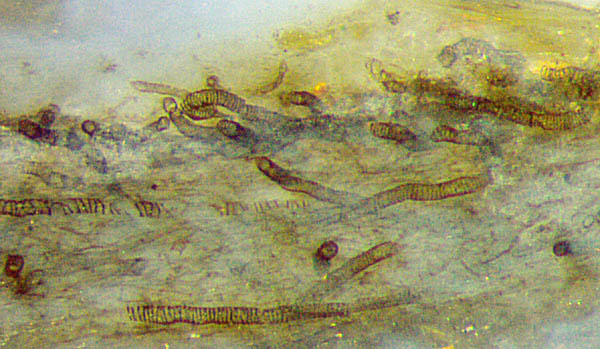

Fig.3: Detail of Fig.1.
Photograph: G. Schmahl.
Image width 0.8mm.
Same magnification
and width for Figs. 2-6.
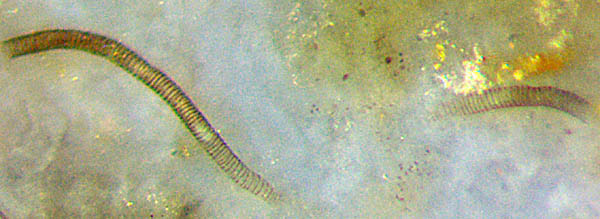
Fig.2 (left): Detail of Fig.1.
Fig.4 (right): separate
Nematoplexus (?) tube,
width 26-28Ám.
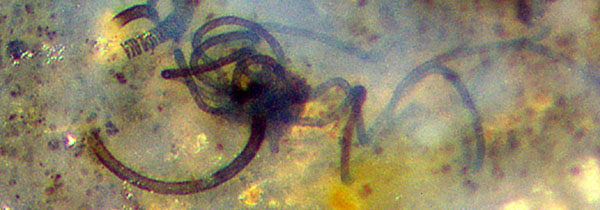
Fig.5 (left): Nematoplexus
"knot", 3 types of tubes.
The
tubes with a more or less irregular mix of annular and helical wall
patterning found with nematophytes are strongly suggestive of an
evolutionary path leading to the tracheids of vascular plants [1].
Therefore they deserve attention. Their existence might be easily
accepted as a peculiar invention serving
some purpose in the
course of evolution if there
were not the disturbing fact that tubes of that type (Fig.4) are often
associated, in small numbers, with the
smooth-walled tubes of Nematoplexus,
a nematophyte of quite different aspect (Fig.5). A
large tube with patterned wall, 25Ám, is seen here only as a short
fragment not attached to but probably related to the clot (known as
"branch-knot" owing to the obsolete idea of profusely branching tubes
inside). The tube of intermediate width in Fig.5, 17Ám, seems to be
smooth-walled but a very faint texture might indicate a narrowly spaced
wall pattern as it is known from tubes of this size on other Nematoplexus
specimens.
There is no obvious reason why many smooth tubes
and a few patterned ones, as in Fig.5, should make a favourable
combination. This is only one of
several enigmas encountered with
Nematoplexus.
Hence it can be stated that it will take some effort to find out the
essential facts about this enigmatic organism.
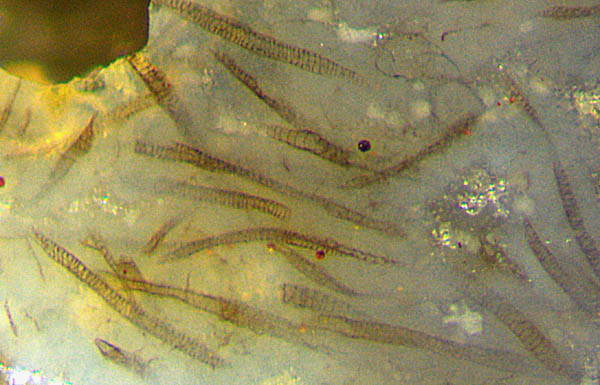
Separate tube fragments with annular or helical
wall
patterns are not rare in the Rhynie chert. It can be difficult to tell
whether they are detached
Nematoplexus
tubes
or the remains of decayed Nematothallus,
or even of tracheophytes. The decayed xylem strand of Asteroxylon
(Fig.6)
could be mistaken for> Nematothallus,
as if the patterned tubes of Nematothallus
had simply been applied for water-conducting components known as
tracheids in tracheophytes.
Fig.6: Tracheids, up to 28Ám across, from disintegrated xylem strand of
Asteroxylon.
Same
magnification and image width for Figs. 2-6.
Apparently, tracheid wall patterns have been a successful detail of
plant life up to now
although it is not quite clear to which purpose.
In the palaeobotany literature one may come across a quite absurd
explanation: It is stated that flowing water in the cells exerts an
underpressure which would cause the cells to collapse if the walls were
not reinforced [2]. This is utter nonsense.
Samples:
Rh9/86.1,2 (0.28kg), found in 2003: Figs.1-5.
Rh9/33.1 (0.07kg), found in
2004
by S.
Weiss: Fig.6.
H.-J.
Weiss 2020
[1]
P.K. Strother: Clarification of the genus Nematothallus Lang: J.
Paleont. 67(1993), 1090-1094.
[2] K.J. Niklas, V.
Smokovitis: Evidence for a
conducting strand in early Silurian plants.
Paleobiology
v.142 (1983), p.103-121.
 |
 |
157 |









